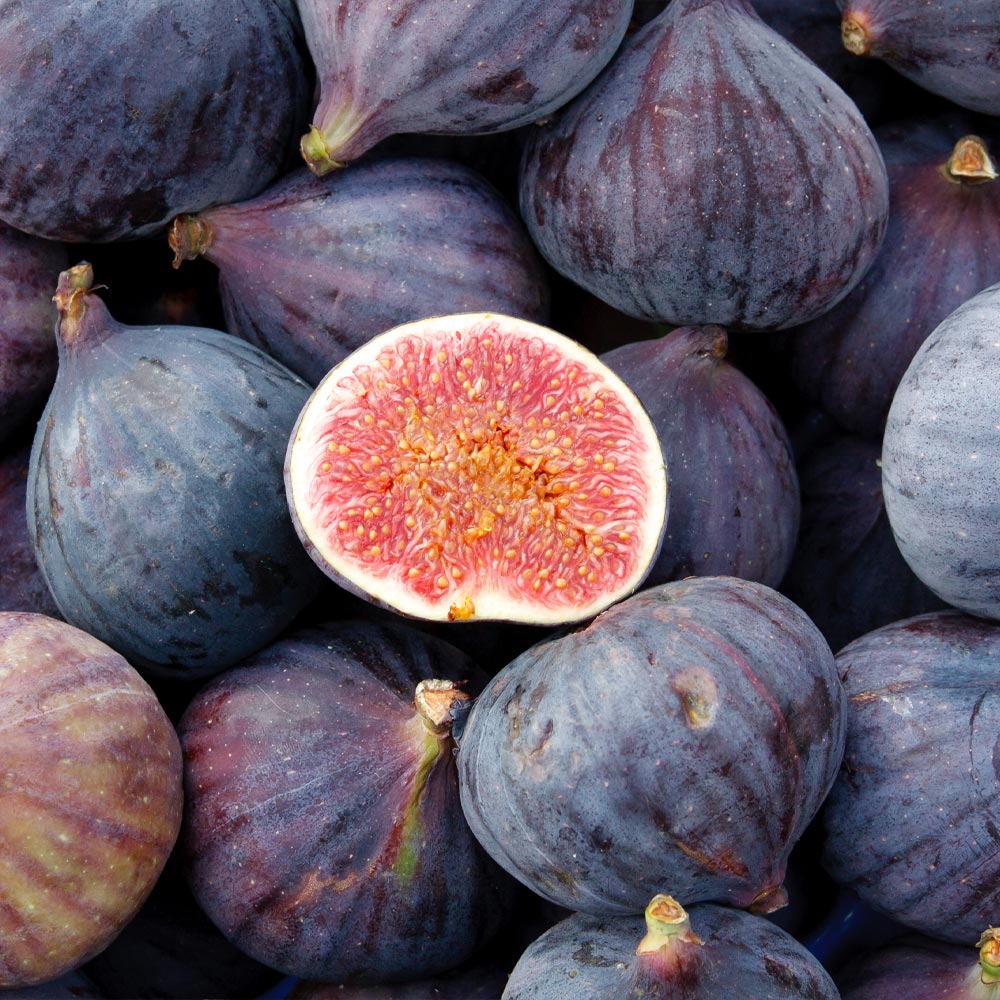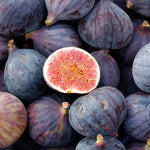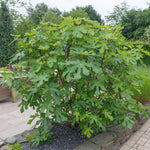LSU Purple Fig Tree Ficus carica

LSU fig trees produce large fruit in spring, summer and fall.


* Images shown are of mature plants
LSU Purple Fig Tree Ficus carica
Product Description
Three Harvests a Year of Sweet and Healthy Figs
You'll enjoy fresh figs all season long when you grow the LSU Purple Fig tree (Ficus carica 'LSU Purple'). The superior result of selective plant breeding, this prolific fig tree bears three separate crops of figs each year '– in early spring, summer, and fall! With fast-growing, low-maintenance, and pest-resistant traits also on its list of outstanding qualities, you may want to go ahead and order your LSU Purple Fig tree while they're still in stock!
High-Quality Fruit That's Also Colorful
Just wait 'til you see these gorgeous figs! They're a rich shade of dark purple, sometimes with a reddish cast, and they hold another colorful surprise inside '– strawberry-colored flesh! But they're not just beautifully colored. LSU Purple Figs have a naturally sweet taste because of their high sugar content, and they're not as "seedy" as other types of figs. The fruits are a good size '– up to 2.5 inches long, with a weight that translates to 15 to 20 figs per pound. If you like fresh figs, you will absolutely love these luscious fruits.
Starts Bearing Fruit When Young
Other types of fig trees may not actually bear fruit until they're 4 or 5 years old, but not LSU Purple Fig tree. It will start bearing figs the same year '– or the next year '– after you plant it! You may not harvest the three crops each year that it's famous for until it is 5 years old, but it'll set fruit before then in either one or two harvests each year. When it does begin to produce three annual harvests, count on a light crop in spring that's followed by the primary, heavy crop in summer. And it'll finish the season with another smaller crop in fall, which sometimes persists through December! Even the first fruits you harvest from young trees will taste delicious, but the flavor and fruit quality of 4- and 5-year-old trees are even more improved.
Best When Fresh
Figs typically don't "hold well," so they're best eaten fresh off the tree or within a day or two after harvesting them. Slice them into your favorite fruit salad; fold them into homemade ice cream; dice them into yogurt; or enjoy them as a topping for your morning oatmeal or cereal. If you want to make a beautiful presentation for a luncheon or summer party, serve LSU Purple Figs on a platter with an assortment of cheeses. You can also stuff these figs with goat cheese as a fruit course for your elegant dinner party.
A heads-up hint: Although you can use LSU Purple Figs to make fig preserves, the syrup that's rendered will be black because of their deep-purple color. The preserves will taste wonderful, but the color may not look very appetizing!
A Nutritional Powerhouse
The North Carolina Cooperative Extension notes that figs have earned the reputation as "one of the world's healthiest foods." Each LSU Purple Fig packs a nutritionally healthy punch in a small package. The fruit sugar they contain provides a natural energy boost, and they are low-fat (approx. 37 calories per medium-sized fruit), sodium-free, cholesterol-free, and fiber-rich. Pectin, which is the water-soluble fiber contained in figs, helps reduce blood cholesterol. Figs also contain iron, calcium, and potassium. Some of the many health benefits of figs (from university research studies) include their ability to reduce breast and colon cancers, lower blood pressure, improve memory, and prevent anemia!
Self-Fruitful Trees Don't Need Cross-Pollination
Many types of fruiting trees can't set fruit unless they're cross-pollinated by another tree, which means you have to purchase at least two trees. But a fig tree is different '– it's "self-fruitful," which means that it can bear fruit without any pollinating help from a companion tree. And there's another difference between fig trees and other fruit trees '– you won't see any flowers! A fig tree doesn't bloom, because the flowers are curiously located inside the figs! If you look at the bottom of a fig '– the area opposite the stem end '– you may see a round spot. This is called an ostiole, or eye. In some types of figs, this eye is slightly open, which allows a tiny wasp to enter the small opening and pollinate the flowers inside. But the LSU Purple Fig tree bears fruits that have a "closed eye" because it doesn't need fig wasps to pollinate its flowers. So when you plant your LSU Fig Tree, you won't have to plant a second tree for cross-pollination, and you won't have to worry about a light fruit set if pollinators are scarce in your area!
Insect- and Disease-Resistant
All this talk about "eyes" on figs is actually quite important when you consider that it's one of the reasons LSU Purple Fig trees are insect- and disease-resistant. These tiny openings on other types of figs are essential for giving pollinating wasps access to the internal flowers, but these openings can also allow harmful insects and fungal diseases to enter the figs. Because LSU Purple Figs have closed eyes, the fruits are sealed to keep insect pests and diseases from spoiling your crop. Open-eyed figs are also susceptible to rotting during rainy weather when rainwater enters the fruit, but your LSU Purple Figs stay sweet and unspoiled because of their closed eyes!
The Result of a Renowned Plant Breeding Program
LSU Purple Fig, not surprisingly, is named for the Louisiana State University fig breeding program that introduced this tree in 1991. The Louisiana Agricultural Experiment Station has a longstanding history of fig research that dates to the 1950s, so you can be sure that your LSU Purple Fig tree has passed stringent laboratory testing and field trials with flying colors.
Figs so Good the Birds May Want to Nibble
You may love your backyard birds, but you may not be willing to share your LSU Purple Figs with them! Many gardeners never have problems with birds eating their figs, but if you experience this, you can try two strategies to outsmart them. Two particular culprits, mockingbirds and blue jays, may find the figs as tasty as you do, but if you harvest ripe figs early in the morning, you'll likely beat the birds to the punch. The mature height of an LSU Purple Fig Tree is 8 to 10 feet, but while it's still small, you can cover it with bird netting when the fruit begins to ripen. And when it's too tall for you to cover completely, you can wrap the lower portion to keep the birds at bay ?… or find a friend with a ladder to cover the entire tree for you!
If Cold Weather Takes a Toll
The LSU Purple Fig tree is a perennial across USDA Plant Hardiness Zones 7 through 10. A particularly cold winter or late-spring freeze may kill the top growth of your tree, but typically the roots are still alive. When the weather warms in spring, new shoots will spring from the ground to rejuvenate your tree! And even if your LSU Purple Fig tree dies to the ground because of freeze injury, it has the potential in a single growing season to grow tall enough to bear fruit later that summer, which is remarkable. By the following year, it should be well on its way to its former fruiting potential. One simple thing you can do to minimize freeze injury, particularly on a young tree, is to water it thoroughly a few days before a hard freeze is predicted. Optionally, you can surround young trees with wire cages that you fill with leaves or straw. This will help insulate your new tree during the winter. Be sure to remove the wire cage in springtime and use the leaves or straw to mulch around your tree, pulling it back from the trunk.
Planting Your Tree
Plan for the mature height of your LSU Purple Fig tree by selecting a site where its maximum growth doesn't interfere with structures or other plants. To keep it healthy and productive, choose a full-sun location that receives at least six hours of direct sun each day '– eight hours is even better! Dig the planting hole only as deep as the rootball of your tree but several times wider, and don't amend the hole with rich soil or organic matter '– backfill it with the soil you removed. Don't add fertilizer when you plant your tree, but water it thoroughly so that you soak the entire rootball.
Caring for Your Tree
Fig trees have shallow root systems, which can be damaged by mower or string trimmers and during times of drought. A simple solution to both these problems is to apply a 3- to 4-inch layer of mulch all around your tree. The mulch cover protects the roots from mowing damage, and it also helps keep the soil moist. Make sure your tree receives 1 inch of water each week during its active growing season if rainfall doesn't supply this amount. If your region experiences a drought in late summer, don't be alarmed if your LSU Purple Fig Tree drops its leaves. This is simply the tree's response to insufficient water, which helps induce dormancy a littler earlier to reduce its watering needs and protect the tree. Fertilize your fig tree according to the results of a soil test, which your local Cooperative Extension Service can provide. In the absence of a soil test, as a rule of thumb, apply 1 pound of 8-8-8 fertilizer (or the organic equivalent) in early spring for every year of the age of your tree (to 10 years old). The 10-pound maximum is then continued for older trees. Bear in mind that too much fertilizer can actually reduce your harvests, which is why a soil test is much better than a random guess!
Pollination Info
LSU Purple Fig Tree Pollination
LSU Purple Fig Trees are self-fertile. You will get fruit with only one plant. However, adding an additional LSU Purple Fig Tree will drastically increase the size of your crop.
Shipping Details
Estimated Shipping Time: Most orders ship within 1-2 days. As noted on the website, some items are seasonal, and may only ship in spring or fall. Once your order is shipped, you'll receive an email with a tracking number.
| Order Total | Shipping Charges |
|---|---|
| Less than $100 | $24.95 |
| $100.00-$128.99 | $29.95 |
| $129 + | FREE SHIPPING! |
Product Details
Growing Zones: 7-10 outdoors
 7-10 outdoors
(hardy down to 10℉)
7-10 outdoors
(hardy down to 10℉)
- Mature Height: 8-10 ft.
- Mature Width: 8-10 ft.
- Sunlight: Full Sun
- Spacing: 10-12 ft.
- Growth Rate: Fast Growing
- Does Not Ship To: AZ, OR
Customer Reviews & Photos





